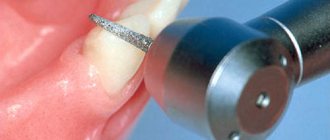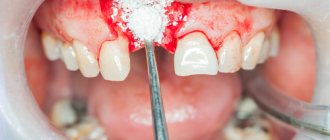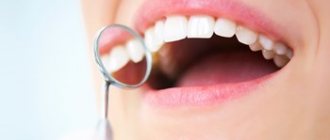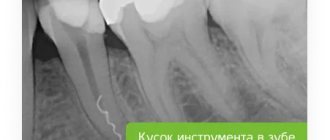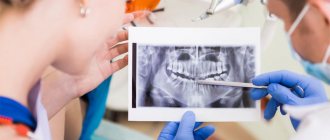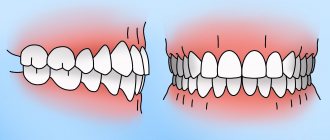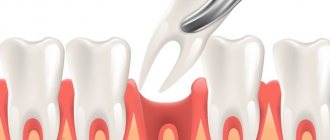X-ray diagnostics during dental implantation is required to identify diseases and contraindications. Using images, the implantologist assesses the condition of the bone tissue, and based on this, selects the appropriate method for installing implants. After the operation, X-ray diagnostics determine whether the structure is installed correctly and whether treatment adjustments are required. For a complete picture, several images are taken using different methods - a targeted image, an orthopantomogram, a computed tomography. Our clinic has its own certified radiology department.
The importance of X-ray diagnostics before implantation
The images allow you to identify obstacles to the installation of implants. They identify problems that can complicate the operation.
Using images, the implantologist determines:
- distance to the mandibular nerve and maxillary sinuses;
- density, volume of bone tissue to select the shape and size of the implant;
- the condition of adjacent teeth to prevent infection from entering the surgical area.
Lack of diagnosis can lead to:
- damage to the nerve and sinuses;
- unstable fixation of the artificial root;
- infection of the operation area;
- reducing the service life of the implant and replacing it with a new one;
- increased sensitivity of the gums due to incorrectly selected orthopedic design.
X-ray diagnostics makes it possible to exclude complications and install implants according to the correctly selected protocol in accordance with the patient’s clinical situation.
Additional specialists and procedures
A patient who has received an appointment for a panoramic dental x-ray may need the help of the following specialists:
- dental surgeon;
- maxillofacial surgeon;
- oncologist;
- otolaryngologist;
- periodontist;
- orthodontist, etc.
OPTG is an important, but not the final stage of diagnosis. To confirm the diagnosis and develop effective therapy, in most cases a number of additional studies are prescribed. If tumors are present, a tissue biopsy is performed. A laboratory examination of pathological discharge is also performed.
If an orthopantomogram indicates problems with the canals or subgingival part of the tooth, it is necessary to open the tooth (filling) and further treatment. In some cases, tooth extraction may be indicated (if it cannot be treated).
Sight shot
A 2D image makes it possible to analyze the condition of 1-3 teeth. For this purpose, a digital radiovisiograph is used.
Allows you to identify inflammatory processes in neighboring teeth, monitor the condition of sealed canals, diagnose damage, and detect pathologies. It can be periapical (study of the tissues around the tooth) and interproximal (analysis of the crown).
Advantages:
- clear image of 1-3 teeth with image magnification;
- safety for the patient, several tests can be done in a row without harm to health.
Flaws:
- 2D image giving only one perspective;
- small visible range.
In our Center, the procedure is performed in a separate X-ray room. The patient is put on a protective apron, the position of the head is fixed, and the radiologist directs a beam of rays to the area being examined.
The procedure takes a few seconds, is painless, and does not cause discomfort.
Panoramic photograph of teeth OPTG
An orthopantomogram gives an idea of the general condition of the dental system - it shows the external and internal condition of the dentition and bone tissue. Performed on an orthopantomograph, a flat two-dimensional panoramic image is obtained - the device combines several images taken in different planes into one. Therefore, OPTG does not accurately convey the image.
The procedure defines:
- ratio of jaw, sinuses;
- location of nerves;
- hidden carious formations;
- damage to seals;
- dental diseases (cyst, periodontal pockets).
Pros:
- full picture of the jaw;
- consideration of a local problem;
- the price is lower than CT.
Minuses:
- two-dimensional images;
- likelihood of misstatement;
- does not determine the angle, thickness of the alveolar processes, structure, position of the jaw.
Before the examination, you need to remove metal jewelry and accessories. To perform OPTG, the patient bites on a special plate to keep the jaws motionless. The orthopantomograph rotates around the patient's head. The procedure lasts from 8 to 20 seconds and does not cause discomfort.
How does the procedure work?
Panoramic photography of teeth is the specialty of a dental radiologist. It is carried out using an orthopantomograph - a modern device that exposes the body to a minimal amount of x-ray radiation.
To take a photo, you need to stand or sit near the device. Next, the patient must wear a protective apron that protects the chest from radiation. When the patient is ready, the doctor starts the orthopantomograph. The entire procedure lasts no more than 15 minutes and is completely painless.
During the process you must remain stationary. After the panoramic photo is taken, you need to wait a few more minutes. During this time, the specialist will prepare the image and provide it to the patient. The entire procedure lasts no more than 15 minutes, including the time required for preparation and waiting.
Computed tomography CT
CT scan is performed on a 3D tomograph. The device's detector generates two-dimensional images, which are combined into a three-dimensional 3D image in a special computer program. The method is more informative than 2D images and allows you to obtain a three-dimensional image of the jaw in high resolution.
CT diagnostics are carried out at the preparatory stage of implantation to identify contraindications and after installation of implants to prevent complications. It is applied for:
- identifying pathologies of the maxillary sinuses;
- determining the condition of bone tissue;
- assessing the location of the mandibular nerve;
- analysis of temporomandibular joints;
- detection of impacted teeth that may interfere with the installation of implants;
- diagnostics of fractures, neoplasms on the jaw.
Advantages:
- accuracy, information content;
- clarity of the picture.
Flaws:
- high price compared to other types of x-ray diagnostics.
The procedure is performed while standing, the patient bites the plate of the device and remains motionless for up to 40 seconds until the device rotates around the head.
Indications
The patient's need for a panoramic photograph of the teeth will be determined by the dentist. It is necessary to do it for a number of diseases of the oral cavity. Among them:
- inflammation of bone tissue;
- bite pathologies;
- tooth abscess;
- joint dysfunction;
- infectious diseases of the jaw;
- periodontal diseases;
- mechanical injuries.
OPTG is also necessarily prescribed when planning orthodontic correction of the dentition. A panoramic photograph allows you to see parts of the teeth that are located under the gums. With its help, the orthodontist can correctly draw up a treatment plan, predict its timing and select teeth that need to be removed (if necessary).
A panoramic photograph must be taken after sustaining jaw injuries (dislocations, fractures, etc.). Its main function is the diagnosis of dental diseases that cannot be determined solely by external signs. For this reason, OPTG is prescribed in the presence of symptoms indicating deep inflammatory and purulent processes.
The doctor gives a referral for a panoramic dental photograph after a visual examination of the oral cavity and collection of anamnesis. This takes into account the presence of pain (especially after canal filling), the nature of the discharge, dysfunction of the jaw joint and other symptoms.
A panoramic photograph is the most informative diagnostic procedure in pediatric dentistry. It is necessary for delayed teething or deviations in their formation. The picture clearly shows the rudiments of baby teeth already in the first months of a child’s life. With the help of OPTG, it is possible to predict bite pathologies and prescribe timely treatment.
With the help of OPTG, it is possible to diagnose diseases of the ENT organs, in particular, diseases of the maxillary sinuses and nasal passages. In this case, a panoramic image is prescribed for dizziness, fever, headache, and breathing discomfort.
Safety
According to the established SanPiN requirements, the annual exposure rate should not exceed 1000 microsieverts. Modern X-ray equipment is safe - the table below shows the radiation exposure during one image and the permissible number of procedures per year.
| Radiation exposure per 1 procedure | Safe number of procedures per year | |
| Sight shot | 1-3 µSv | 500 |
| OPTG | 13-17 µSv | 80 |
| CT | 50-60 µSv | 20 |
| Type of diagnosis | Radiation exposure per 1 procedure | Safe number of procedures per year |
| Sight shot | 1-3 µSv | 500 |
| OPTG | 13-17 µSv | 80 |
| CT | 50-60 µSv | 20 |
X-ray diagnostics are not recommended during the first and last trimester of pregnancy.
Our clinic uses a safe device that meets international standards
The digital X-ray system with a minimum level of radiation SIEMENS SIRONA GALILEOS allows you to perform the most accurate studies for patients. The device is intended for the study of bone tissue, tooth roots, temporomandibular joint, nasopharynx, and upper spine. An analysis of local problems and the condition of a large volume of jaw tissue is carried out.
Levin Dmitry Valerievich
Chief physician, Ph.D.
Price
Diagnostics in our Center is included in the cost of implantation consultation:
- drawing up a treatment plan, CT scan with examination on a computer screen without decoding and recording on DVD - 3000 rubles. ;
- drawing up a treatment plan, CT scan with interpretation, recording on DVD - 5200 rubles.
When installing implants in our Center, consultation and x-ray examination are included in the package, diagnostics after surgery is carried out free of charge. Funds spent before the start of treatment are credited to the patient’s account in the form of an advance.
You can view pricing at our clinic here.
Types of X-rays in dentistry
Dr. Kizim
>
Articles
>
Types of X-rays in dentistry
The work of a radiologist in dentistry is very important; only high-quality radiographs allow doctors to draw up correct treatment plans for patients in the shortest possible time.
In dentistry, there are several types of x-ray examinations:
— targeted shot;
— orthopantomogram (panoramic image);
— cone beam computed tomography (3D image).
At the Center for Dentistry and Basal Implantation, all these examinations are carried out by radiologist Ruslan Albertovich Baterikov. In our clinic we use equipment from the Finnish company Planmeca Pro max 3D of the highest precision with minimal radiation doses. You can find out the cost of services in the “ Prices ” section.
Find out details
A targeted image allows you to establish the true causes of the patient’s complaints, outline an effective treatment plan and monitor its results. The image gives an idea of the anatomical structure of the tooth, the condition of all its internal elements, and the presence of an inflammatory process both in the tooth itself and in the periodontal tissues.
A targeted photograph is prescribed by a dentist:
- for high-quality treatment of caries - to determine the depth of carious lesions;
- when removing teeth - to determine the state of tooth eruption and determine the number of tooth roots;
- during endodontic treatment, treatment of tooth canals, pulpitis and periodontitis - allows you to assess the condition of the canals before treatment, the quality of their preparation for filling and the correctness of filling.
Orthopantomogram is a type of X-ray examination of the entire dental system or a panoramic photograph of the jaws showing all teeth, as well as soft tissues, sinuses, maxillary sinuses, and the temporomandibular joint. The image is displayed in two-dimensional format.
The examination of each patient begins with this image, since, having an orthopantomogram, the doctor can give a comprehensive consultation about the condition of the patient’s oral cavity and begin timely treatment of diseases that have not yet manifested themselves.
An orthopantomogram is prescribed by a dentist:
- at the initial consultation when the patient comes to the clinic for the purpose of a complete diagnosis of the condition of the oral cavity, drawing up a complete rehabilitation plan and full treatment of the patient;
- when removing wisdom teeth, especially if these are complex removals of impacted and dystopic teeth;
- to assess bite pathology during orthodontic treatment;
- to determine anomalies of occlusion during orthopedic and orthodontic treatment for the full restoration of the bite and chewing process.
Cone beam computed tomography is the latest method of three-dimensional diagnostics of the entire dental system. With this study, you can see any part of the maxillofacial region from different angles. This type of x-ray diagnostics provides the most comprehensive information about the condition of the patient’s dental system. When planning dental implantation using CBCT, the operation is bloodless and with the least trauma to the body, since the surgeon has determined in advance a safe place and angle for installing the implant, which completely eliminates the possibility of touching dangerous areas of the jaw. Osteoplastic and maxillofacial surgeries are also greatly simplified.
Cone beam computed tomography is prescribed by a dentist:
- for complex diagnostics of the dental system to determine a comprehensive treatment plan;
- to determine the degree of infection of the tooth canals in complicated caries, pulpitis, periodontitis;
- to identify cysts and neoplasms in the jaw bone, during inflammatory processes in the maxillary sinuses;
- to determine the condition of bone tissue, the location of nerve canals and the level of pneumatization of the maxillary sinuses;
- when planning implantation, osseoplastic and maxillofacial operations;
- to determine occlusion anomalies during orthopedic and orthodontic treatment for complete restoration of the bite and chewing process;
- to assess bite pathology during orthodontic treatment;
- for diagnosing the temporomandibular joint in case of its dysfunction.
